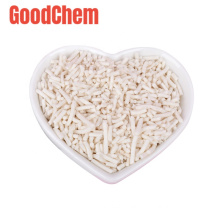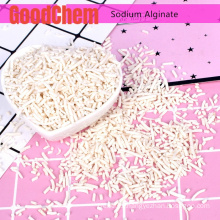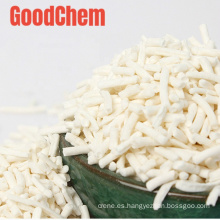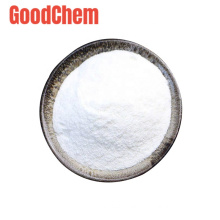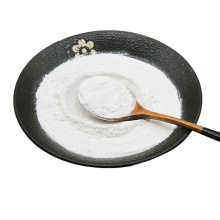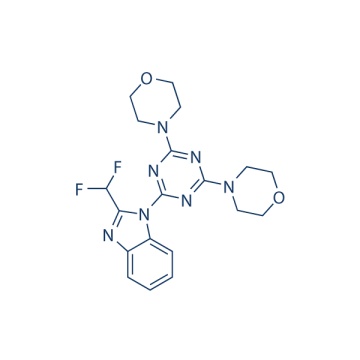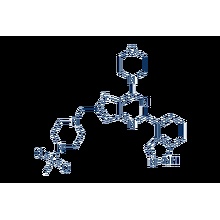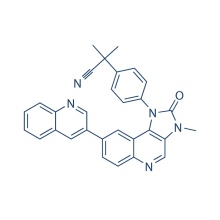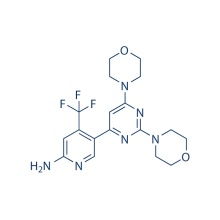.cp_wz tabla {borde superior: 1px sólido #ccc; borde izquierdo: 1px sólido #ccc; } .cp_wz table td {borde derecho: 1px sólido #ccc; borde inferior: 1px sólido #ccc; padding: 5px 0px 0px 5px;} .cp_wz table th {border-right: 1px solid #ccc; border-bottom: 1px solid #ccc; padding: 5px 0px 0px 5px;} \ n Peso molecular: 417.41 ZSTK474 inhibe las isoformas de PI3K de clase I con IC50 de 37 nM, principalmente PI3Kδ. Phase1 / 2. \ N ZSTK474 a 1 μM reduce potencialmente la actividad de PI3K al 4,7% del nivel de control, mientras que LY2194002 solo reduce la actividad al 44,6% del control. ZSTK474 inhibe las actividades de p110β, -γ y -δ recombinantes con IC50 de 17 nM, 53 nM y 6 nM, respectivamente. ZSTK474 muestra una potente actividad antiproliferativa contra un panel de 39 líneas celulares de cáncer humano con un GI50 medio de 0,32 µM, más eficazmente que el de LY294002 o wortmanina con un GI50 medio de 7,4 µM o 10 µM, respectivamente. El tratamiento con ZSTK474 a 1 μM bloquea la ondulación de la membrana y la generación de PIP3 inducida por el factor de crecimiento derivado de plaquetas en fibroblastos embrionarios murinos (MEF). ZSTK474 a 10 μM induce la apoptosis en las células OVCAR3 e induce la detención completa de la fase G1, pero no la apoptosis en las células A549. El tratamiento con ZSTK474 a 0,5 µM disminuye significativamente el nivel de Akt fosforilada y GSK-3β, así como la expresión de la proteína ciclina D1. ZSTK474 también inhibe la fosforilación de otros componentes de señalización posteriores que participan en la regulación de la proliferación celular, incluidos FKHRL1, FKHR, TSC-2, mTOR y p70S6K de una manera dependiente de la dosis. ZSTK474 no inhibe mTOR a 0,1 μM, e incluso a una concentración de 100 μM, ZSTK474 inhibe la actividad de mTOR menos del 40%. ZSTK474 bloquea la migración celular inducida por VEGF y la formación de tubos en células endoteliales de la vena umbilical humana (HUVEC) e inhibe la expresión de HIF-1α y la secreción de VEGF en células RXF-631L, exhibiendo una potente actividad antiangiogénica in vitro. El tratamiento con ZSTK474 inhibe la producción de IFNγ e IL-17 en las células T activadas con concanavalina A e inhibe la proliferación y producción de PGE (2) por las células sinoviales similares a fibroblastos (FLS).
orte
|
Inhibition of PI3K activity
|
A549 cells are lysed in a buffer containing 20 mM Tris-HCl (pH 7.5), 150 mM NaCl, 5 mM EDTA, and 1% Igepal CA-630, the lysates are centrifuged at 20,000 g and 4 °C for 10 minutes, and the supernatants are used as cell lysate (protein = 2-4 mg/mL). To immunoprecipitate PI3K, 200 μL of cell lysate are incubated with anti-p85 polyclonal antibody and protein G-agarose (5 μL). PI3Kα, PI3Kβ, and PI3Kδ can be immunoprecipitated by the anti-p85 polyclonal antibody. Agarose beads containing immunoprecipitates are washed twice with buffer A (20 mM Tris-HCl at pH 7.5, 150 mM NaCl, 5 mM EDTA, and 1% Igepal CA-630), once with buffer B (500 mM LiCl and 100 mM Tris-HCl at pH 7.5), once with distilled water, and once with buffer C (100 mM NaCl and 20 mM Tris-HCl at pH 7.5). Immunoprecipitates are suspended in 20 μL of buffer C containing phosphatidylinositol of 200 μg/mL. The mixture is preincubated with increasing concentrations of ZSTK474 at 25 °C for 5 minutes. [γ-32P]ATP (2 μCi per assay mixture; final concentration, 20 μM) and MgCl2 (final concentration, 20 mM) are added to start the reaction. The reaction mixture is incubated at 25 °C for 20 minutes. Phosphorylated products of phosphatidylinositol are separated by thin-layer chromatography and visualized by autoradiography. The phosphatidylinositol-3-phosphate region is scraped from the plate, and radioactivity is also measured with liquid scintillation spectroscopy. The level of inhibition for ZSTK474 is determined as the percentage of 32P counts per minute obtained without ZSTK474.
|
Ensayo celular: [1]
|
Cell lines
|
MCF-7, HT-29, HCT-116, OVCAR3, A549, et al.
|
|
Concentrations
|
Dissolved in DMSO, final concentrations ~10 μM
|
|
Incubation Time
|
48 hours
|
|
Method
|
Cells are exposed to increasing concentrations of ZSTK474 for 48 hours. The inhibition of cell proliferation is assessed by measuring changes in total cellular protein by use of a sulforhodamine B assay. Apoptosis is assessed by chromatin condensation or by flow cytometry. For chromatin condensation assay, cells are stained with Hoechst 33342 and examined by fluorescence microscopy. Morphologic changes induced by ZSTK474, such as the condensation of chromatin, are indicative of apoptosis. For flow cytometry analysis, cells are harvested, washed with ice-cold PBS, and fixed in 70% ethanol. Cells are then washed twice with ice-cold PBS again, treated with RNase A (500 μg/mL) at 37 °C for 1 hour, and stained with propidium iodide (25 μg/mL). The DNA content of the cells is analyzed with a flow cytometer.
|
Estudio con animales: [1]
|
Animal Models
|
Male BDF1 mice injected subcutaneously with B16F10 cells, and female BALB/c nude mice inoculated subcutaneously with A549, PC-3, or WiDr cells
|
|
Formulation
|
Suspended in 5% hydroxypropylcellulose in water as a solid dispersion form
|
|
Dosages
|
~400 mg/kg/day
|
|
Administration
|
Orally
|
|
Solubility
|
0.5% hydroxyethyl cellulose,
30 mg/mL
|
|
* Please note that Selleck tests the solubility of all compounds in-house, and the actual solubility may differ slightly from published values. This is normal and is due to slight batch-to-batch variations.
|
Conversión de diferentes modelos de animales basados en BSA (valor basado en datos del Borrador de Directrices de la FDA)
|
Species
|
Baboon
|
Dog
|
Monkey
|
Rabbit
|
Guinea pig
|
Rat
|
Hamster
|
Mouse
|
|
Weight (kg)
|
12
|
10
|
3
|
1.8
|
0.4
|
0.15
|
0.08
|
0.02
|
|
Body Surface Area (m2)
|
0.6
|
0.5
|
0.24
|
0.15
|
0.05
|
0.025
|
0.02
|
0.007
|
|
Km factor
|
20
|
20
|
12
|
12
|
8
|
6
|
5
|
3
|
|
Animal A (mg/kg) = Animal B (mg/kg) multiplied by
|
Animal B Km
|
|
Animal A Km
|
Por ejemplo, para modificar la dosis de resveratrol utilizada para un ratón (22,4 mg / kg) a una dosis basada en el BSA para una rata, multiplique 22,4 mg / kg por el factor Km para un ratón y luego divida por el factor Km para una rata. Este cálculo da como resultado una dosis equivalente para ratas de resveratrol de 11,2 mg / kg.
|
Rat dose (mg/kg) = mouse dose (22.4 mg/kg) ×
|
mouse Km(3)
|
= 11.2 mg/kg
|
|
rat Km(6)
|
Información química
|
Molecular Weight (MW)
|
417.41
|
|
Formula
|
C19H21F2N7O2
|
|
CAS No.
|
475110-96-4
|
|
Storage
|
3 years -20℃Powder
|
|
6 months-80℃in solvent (DMSO, water, etc.)
|
|
Synonyms
|
|
|
Solubility (25°C) *
|
In vitro
|
DMSO
|
21 mg/mL
(50.31 mM)
|
|
Water
|
<1 mg/mL
(
|
|
Ethanol
|
<1 mg/mL
(
|
|
In vivo
|
0.5% hydroxyethyl cellulose
|
30 mg/mL
|
* <1 mg/ml means slightly soluble or insoluble.
* Please note that Selleck tests the solubility of all compounds in-house, and the actual solubility may differ slightly from published values. This is normal and is due to slight batch-to-batch variations.
|
|
Chemical Name
|
2-(difluoromethyl)-1-(4,6-dimorpholino-1,3,5-triazin-2-yl)-1H-benzo[d]imidazole
|
Calculadora de molaridad Calculadora de dilución Calculadora de peso molecular
Grupos de Producto : PI3K / Akt / mTOR > Inhibidor de PI3K
